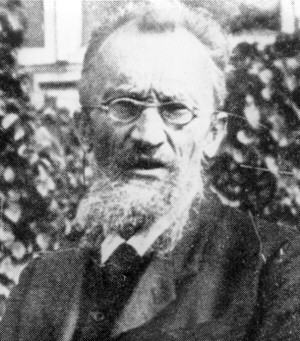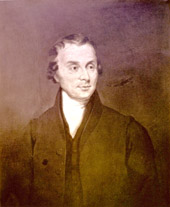
In meteorology, a cloud is an aerosol consisting of a visible mass of miniature liquid droplets, frozen crystals, or other particles suspended in the atmosphere of a planetary body or similar space. Water or various other chemicals may compose the droplets and crystals. On Earth, clouds are formed as a result of saturation of the air when it is cooled to its dew point, or when it gains sufficient moisture from an adjacent source to raise the dew point to the ambient temperature.

Georg Balthazar von Neumayer, was a German polar explorer and scientist who was a proponent of the idea of international cooperation for meteorology and scientific observation.

A weather balloon, also known as sounding balloon, is a balloon that carries instruments aloft to send back information on atmospheric pressure, temperature, humidity and wind speed by means of a small, expendable measuring device called a radiosonde. To obtain wind data, they can be tracked by radar, radio direction finding, or navigation systems. Balloons meant to stay at a constant altitude for long periods of time are known as transosondes. Weather balloons that do not carry an instrument pack are used to determine upper-level winds and the height of cloud layers. For such balloons, a theodolite or total station is used to track the balloon's azimuth and elevation, which are then converted to estimated wind speed and direction and/or cloud height, as applicable.

Cirrocumulus is one of the three main genus-types of high-altitude tropospheric clouds, the other two being cirrus and cirrostratus. They usually occur at an altitude of 5 to 12 km. Like lower-altitude cumuliform and stratocumuliform clouds, cirrocumulus signifies convection. Unlike other high-altitude tropospheric clouds like cirrus and cirrostratus, cirrocumulus includes a small amount of liquid water droplets, although these are in a supercooled state. Ice crystals are the predominant component, and typically, the ice crystals cause the supercooled water drops in the cloud to rapidly freeze, transforming the cirrocumulus into cirrostratus. This process can also produce precipitation in the form of a virga consisting of ice or snow. Thus, cirrocumulus clouds are usually short-lived. They usually only form as part of a short-lived transitional phase within an area of cirrus clouds and can also form briefly as a result of the breaking up of part of a cumulonimbus anvil.

Cirrostratus is a high-level, very thin, generally uniform stratiform genus-type of cloud. It is made out of ice-crystals, which are pieces of frozen water. It is difficult to detect and it can make halos. These are made when the cloud takes the form of thin cirrostratus nebulosus. The cloud has a fibrous texture with no halos if it is thicker cirrostratus fibratus. On the approach of a frontal system, the cirrostratus often begins as nebulous and turns to fibratus. If the cirrostratus begins as fragmented of clouds in the sky it often means the front is weak. Cirrostratus is usually located above 5.5 km (18,000 ft). Its presence indicates a large amount of moisture in the upper troposphere. Clouds resembling cirrostratus occasionally form in polar regions of the lower stratosphere. Polar stratospheric clouds can take on this appearance when composed of tiny supercooled droplets of water or nitric acid.
The timeline of meteorology contains events of scientific and technological advancements in the area of atmospheric sciences. The most notable advancements in observational meteorology, weather forecasting, climatology, atmospheric chemistry, and atmospheric physics are listed chronologically. Some historical weather events are included that mark time periods where advancements were made, or even that sparked policy change.
The International Meteorological Organization was the first organization formed with the purpose of exchanging weather information among the countries of the world. It came into existence from the realization that weather systems move across country boundaries; and that knowledge of pressure, temperature, precipitations, etc. upstream and downstream is needed for weather forecasting. It was superseded by the World Meteorological Organization.

Léon Philippe Teisserenc de Bort was a French meteorologist and a pioneer in the field of aerology. Together with Richard Assmann (1845-1918), he is credited as co-discoverer of the stratosphere, as both men announced their discovery during the same time period in 1902. Teisserenc de Bort pioneered the use of unmanned instrumented balloons and was the first to identify the region in the atmosphere around 8-17 kilometers of height where the lapse rate reaches zero, known today as the tropopause.

Wladimir Peter Köppen was a Russian-German geographer, meteorologist, climatologist and botanist. After studies in St. Petersburg, he spent the bulk of his life and professional career in Germany and Austria. His most notable contribution to science was the development of the Köppen climate classification system, which, with some modifications, is still commonly used. Köppen made significant contributions to several branches of science, and coined the name aerology for the science of measuring the upper air / atmosphere.

Luke Howard, was a British manufacturing chemist and an amateur meteorologist with broad interests in science. His lasting contribution to science is a nomenclature system for clouds, which he proposed in an 1802 presentation to the Askesian Society. Because of this, Howard is referred to as "The Godfather of Clouds", the "namer of the clouds", and the "father of meteorology".

Ferdinand Jules Quénisset (1872–1951) was a French astronomer who specialized in astrophotography.

The climate in Greece is predominantly Mediterranean. However, due to the country's geography, Greece has a wide range of micro-climates and local variations. The Greek mainland is extremely mountainous, making Greece one of the most mountainous countries in Europe. To the west of the Pindus mountain range, the climate is generally wetter and has some maritime features. The east of the Pindus mountain range is generally drier and windier in summer. The highest peak is Mount Olympus, 2,918 metres (9,573 ft). The northern areas of Greece have a transitional climate between the continental and the Mediterranean climate. There are mountainous areas that have an alpine climate.

Abbott Lawrence Rotch was an American meteorologist and founder of the Blue Hill Meteorological Observatory, the longest continually operating observation site in the United States and an important site for world climatology.

Arthur Josef Stanislaus Berson was a German meteorologist and pioneer of aerology who was a native of Neu Sandez, Galicia.

The International Cloud Atlas or simply the Cloud Atlas, is a cloud atlas that was first published in 1896 and has remained in print since. Its initial purposes included aiding the training of meteorologists and promoting more consistent use of vocabulary describing clouds, which were both important for early weather forecasting. The first edition featured color plates of color photographs, then still a very new technology, but noted for being expensive. Numerous later editions have been published.

Albert Riggenbach, also known as Albert Riggenbach-Burckhardt, was a Swiss meteorologist and co-author, with Hugo Hildebrandsson and Léon Teisserenc de Bort, of one of the first cloud atlases, the International Cloud Atlas in 1896. His doctoral dissertation (Habilitationsschrift) concerned observations of the first described Bishop's Ring.

Hugo Hildebrand Hildebrandsson was a Swedish meteorologist and professor at Uppsala university between 1878 and 1907.

Ralph Abercromby was a Scottish meteorologist.
The Symons Gold Medal is awarded biennially by the Royal Meteorological Society for distinguished work in the field of meteorological science.

A castellanus is a cloud that displays at least in its upper part cumuliform protuberances having the shape of turrets that give a crenellated aspect. Some of these turrets are higher than they are wide; they have a common base and seem to be arranged in a line. The castellanus characteristic is particularly obvious when the clouds are observed from the side.

















